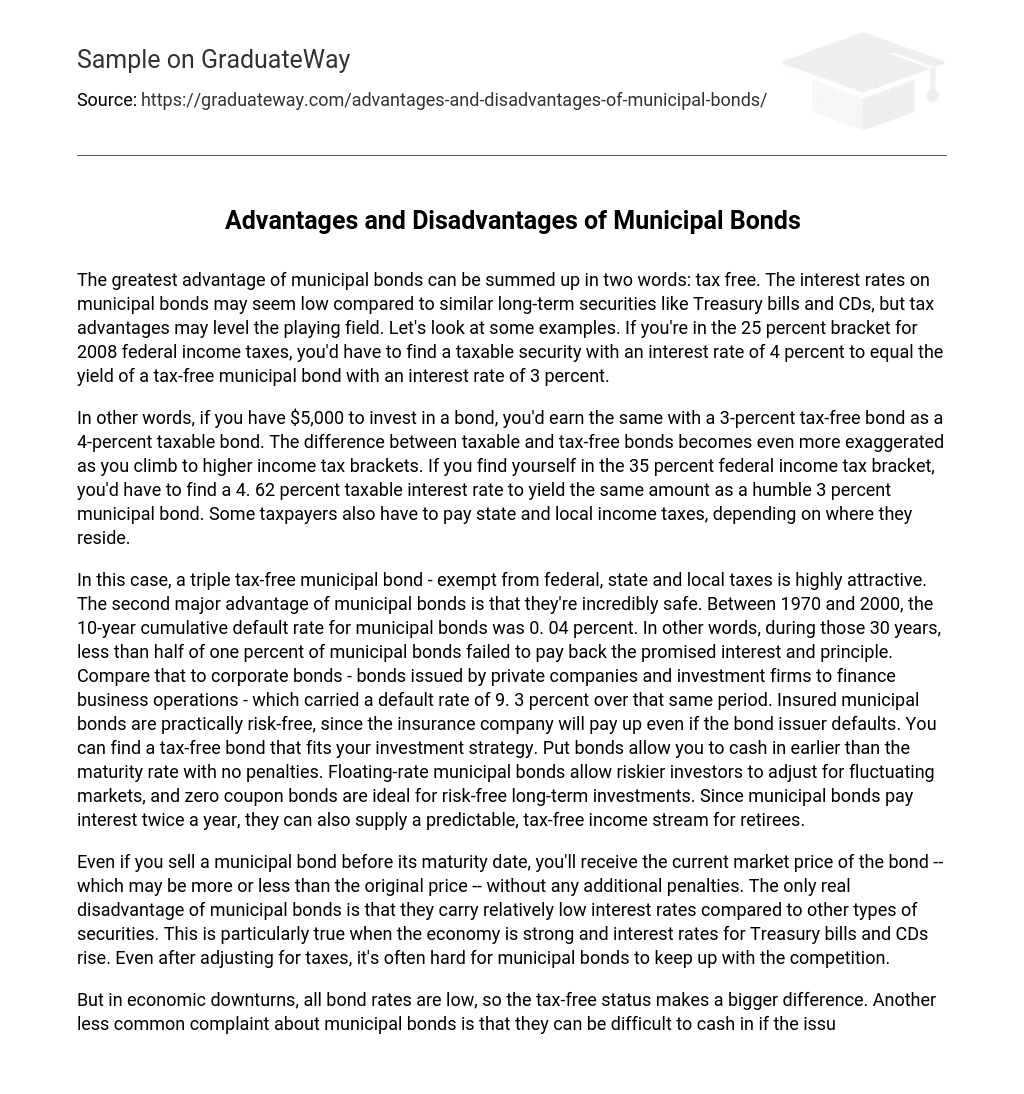Municipal bonds have a notable advantage because they are not subject to taxes. While the interest rates on municipal bonds may seem lower compared to other long-term securities like Treasury bills and CDs, the tax benefits can offset this discrepancy. To demonstrate this, let’s consider a few examples. If you are in the 25 percent federal income tax bracket in 2008, you would need to find a taxable security with a 4 percent interest rate to equal the yield of a tax-free municipal bond with a 3 percent interest rate.
Both a 3-percent tax-free bond and a 4-percent taxable bond, with an investment of $5,000, will generate similar returns. However, as the income tax bracket increases, the distinction between taxable and tax-free bonds becomes more apparent. For instance, individuals in the 35 percent federal income tax bracket would require a 4.62 percent taxable interest rate to match the earnings of a conservative 3 percent municipal bond. It is important to note that certain taxpayers may be subject to state and local income taxes depending on their place of residence.
The attractiveness of a tax-free municipal bond that is exempt from federal, state, and local taxes is high. Additionally, these bonds offer a high level of safety. From 1970 to 2000, the cumulative default rate for municipal bonds over a 10-year timeframe was only 0.04 percent – meaning less than half of one percent of these bonds failed to repay the promised interest and principal throughout those 30 years. In contrast, corporate bonds issued by private companies and investment firms for business operations had a default rate of 9.3 percent during the same period.
Insured municipal bonds are nearly entirely risk-free as the insurance company will provide compensation if the bond issuer defaults. There are different types of tax-free bonds available to cater to various investment strategies: put bonds allow early redemption without penalty, floating-rate municipal bonds can be adjusted based on fluctuating markets, and zero-coupon bonds are suitable for long-term risk-free investments.
Furthermore, since municipal bonds pay interest twice annually, they can provide retirees with a predictable tax-free income stream.
Selling a municipal bond before its maturity enables you to obtain the present market price, irrespective of any disparities from the initial price. Nevertheless, municipal bonds tend to have relatively lower interest rates compared to other securities, especially when the economy is robust and interest rates for Treasury bills and CDs are increasing. Despite considering taxes, municipal bonds frequently encounter challenges in competing.
During an economic downturn, bond rates decrease for all types of bonds, highlighting the importance of tax-free municipal bonds. However, obtaining these benefits can be difficult when dealing with smaller municipalities like rural county governments. This article will explore how to acquire municipal bonds and decide where they fit in our investment portfolio. Before investing in these bonds, it’s crucial to carefully evaluate their pros and cons to make an informed decision. So what exactly does the term “municipal bond” mean?
To provide assistance, we will explore the pros and cons of this investment tool so that you can make informed investment decisions. A significant benefit of municipal bonds is their typical tax exemption. This implies that you needn’t worry about paying taxes on your interest income, especially at the federal level. Nonetheless, depending on where you are located, you may still have to pay state and local taxes unless you choose a triple tax-free bond which waives taxation at all three levels.
Related articles JP
Morgan Chase and Ally Bank are currently facing lawsuits over their mortgage bond losses, while the U.S. Treasury is digitizing paper savings bonds. Interestingly, savings bonds have become a popular investment option, despite typically offering lower interest rates than T-bills or CDs. Nevertheless, many investors find municipal bonds attractive due to their tax-exempt status, ultimately making them more profitable.
Investing in municipal bonds offers the benefit of low risk as they are supported by your municipality’s activities or credit, with sufficient funds typically available to cover interest and the full investment amount upon maturity. In fact, their default rate was a mere 0.04 percent from 1970 to 2000. However, one drawback is the challenge of cashing in.
Redeeming your bond may be challenging if you live in a remote location without access to funds. To make wise decisions about investing in municipal bonds, gather as much information as possible before committing financially. Now that you have more knowledge about municipal bonds, it’s important to learn how to purchase them.





